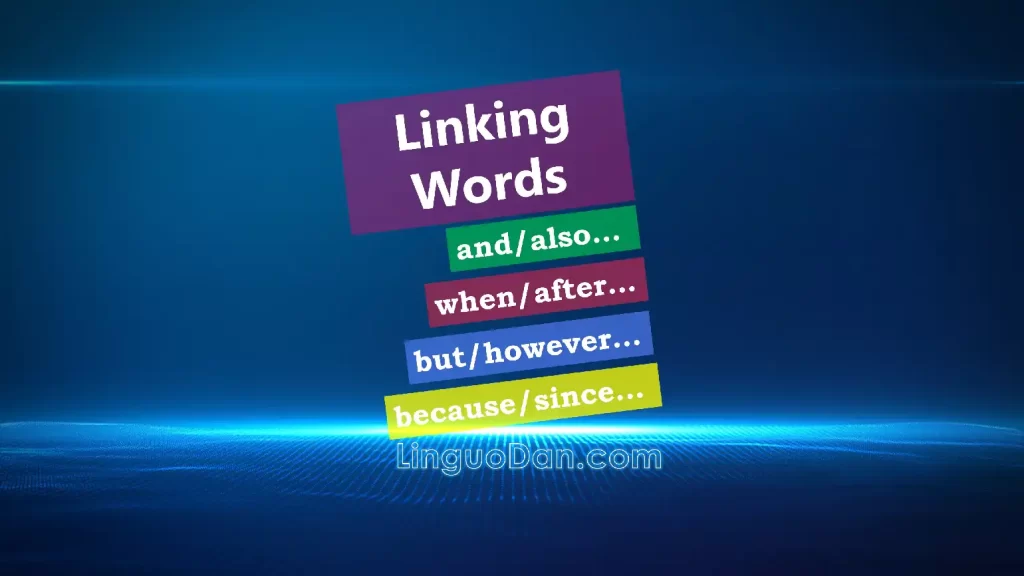Linking Words types and usage in English

Linking words in English in practice
Linking words or transition words are conjunctions used in the English language to connect homogeneous sentence elements and parts of a complex sentence, structuring the text and conveying logical coherence between different parts of speech. The difficulty in learning them lies in choosing the most suitable word for a given sentence. That is why, in this article, we will explore the categories or types of linking words in the English language and how to use them correctly. At the end, there is a test with 10 questions to assess your knowledge.
What are Linking Words?
Linking words are conjunctions, meaning they are words and phrases that connect sentences, parts of sentences, or other words. They are used to link various parts of a text, providing it with sequence and logical coherence. Linking words can indicate the relationship between ideas, introduce new aspects, specify, or modify the conversation. For example:
- I like chocolate and ice cream.
- She is smart but lazy.
- He went to the park because he wanted to play.
What are the types and uses of Linking Words in English?
There are many different types of linking words used in the English language for different purposes. Let’s consider the most popular of them:
- Addition: For expanding on an idea, addition linking words come into play. Phrases like “in addition,” “furthermore,” “moreover,” “also,” and “as well as” are used to compound information, adding layers to the narrative.
Example: “She is a skilled pianist. Furthermore, she composes her own music.”
- Contrast: When presenting opposing views or contrasting ideas, words like “however,” “nevertheless,” “on the other hand,” and “conversely” succinctly express the divergence in thought.
Example: “The road was clear. However, we still arrived late due to an unexpected detour.”
- Cause and Effect: Linking words such as “therefore,” “thus,” “as a result,” and “hence” illustrate the relationship between cause and effect, highlighting the impact of one event on another.
Example: “He didn’t study for the test; as a result, he scored poorly.”
- Sequence: To depict a certain order or timeline within your text, sequence linking words like “firstly,” “secondly,” “then,” “next,” and “finally” are used.
Example: “Firstly, gather all the ingredients. Secondly, preheat the oven. Finally, mix the batter before baking.”
- Illustration: When providing examples, “for instance,” “for example,” “namely,” and “such as” are employed to elucidate a point more concretely.
Example: “Several fruits are rich in vitamin C; for example, oranges and strawberries.”
- Comparison: For drawing parallels, phrases like “similarly,” “likewise,” and “in the same way,” are used to associate one idea with another.
Example: “He is meticulous in his work, similarly to his sister who is an exceptional student.”
- Summary: To wrap up arguments or ideas, summary linking words like “in summary,” “in conclusion,” “to sum up,” and “overall” signal closure and synthesis of information.
Example: “In conclusion, linking words are essential for effective communication.”
- Emphasis: To underscore a point or idea, emphasis linking words such as “indeed,” “certainly,” “actually,” and “in fact” can be quite impactful.
Example: “She indeed won the competition, against all odds.”
Examples with Linking Words
Let’s consider some examples of linking words that are used for different purposes. Here are some of them:
- Linking words that show an additional idea or similarity: and, also, too, as well as, in addition, furthermore, moreover, besides, likewise, similarly, not to mention, etc.
- Example: I like chocolate and ice cream.
- Linking words that show the opposite idea or contrast: but, however, although, though, even though, despite, in spite of, whereas, while, on the other hand, nevertheless, nonetheless, etc.
- Example: She is smart but lazy.
- Linking words that show cause or effect: because, since, as, for, so, therefore, thus, hence, consequently, as a result, due to, owing to, etc.
- Example: He went to the park because he wanted to play.
- Linking words that show a condition or possibility: if, unless, whether, provided that, as long as, in case, suppose that, etc.
- Example: I will go to the cinema if you come with me.
- Linking words that show time or sequence: when, after, before, until, as soon as, while, as long as, since, then, next, finally, first, second, third, etc.
- Example: She called me after she finished her homework.
Exercise on using linking words – test